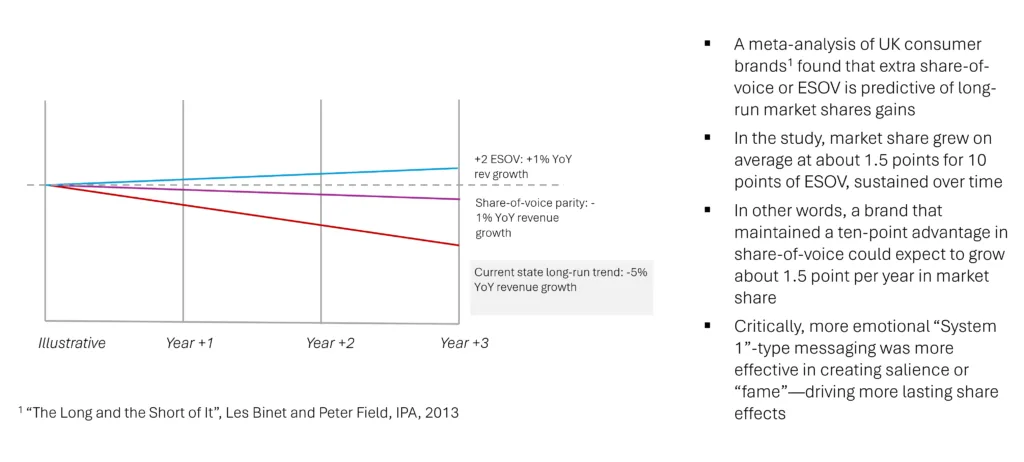In the hyper-connected digital era, where immediate results and short-term metrics often dominate the marketing narrative, communicating the long-term benefits of brand investment to finance-focused decision-makers can be challenging. Using a seminal study that bridges the gap between theory and practice, this article explores the common challenges faced by marketers and provides actionable best practices.
Insightful Revelations from the Binet Study
In 2010, Les Binet and Peter Field unveiled groundbreaking findings about the significance of “extra share-of-voice” (ESOV) for predicting long-term market share growth among UK consumer brands. They found that brands with higher ESOV experienced growth, while those underinvesting in brand marketing saw a decrease.
Key takeaways from the study include:
- A brand maintaining a 10-point advantage in share-of-voice (“extra” share-of-voice) could anticipate a yearly market share growth of about 1.5 points.
- Brands using emotion-rich “System 1”* messaging built stronger connections, increasing the chances of long-term market share growth.
* System 1 messaging relies on emotional and intuitive appeals to evoke immediate, unconscious consumer reactions.

The study’s findings highlight the importance of brand building and competing for share-of-voice to achieve lasting market share gains. By investing in advertising and creating emotional connections with their audience, companies can build a strong brand identity that drives sustainable growth.
Challenges to Measuring the Impact of Brand
When CMOs advocate for brand investments, they face the tough task of quantifying benefits to CFOs. How do you measure the essence of something intangible yet undeniably powerful? Why is it so hard to measure the impact of brand marketing?
- Lack of Direct Causality: Unlike performance marketing, where ad spend directly correlates with sales, brand marketing slowly molds consumer behavior requiring longer-term tests.
- Persistency of Brand Effects: Brand investments have long-lasting effects that accumulate over time, making it harder to pinpoint the impact of individual campaigns or strategies.
- Data Quality and Access: Accurate brand impact measurement requires diverse data sources, including consumer surveys and sales data. This can be challenging, particularly for new or resource-limited businesses.
As a result of these complexities, companies often fall into the “Brand Measurement Trap,” prioritizing short-term, easily measurable tactics over long-term brand building. Without the tools to properly assess brand marketing impact, businesses could miss avenues for sustained growth.
Best Practices for Measuring the Impact of Brand
Using the following five best practices, CMOs can deliver measurable data showing the value of brand investment.
1. Embrace a Long-Term Vision
Re-define brand marketing not as a mere expenditure but as a strategic long-term investment. Upper funnel investments take longer to manifest than down funnel performance marketing tactics. Harness ad stocking—a technique applying campaign stimulus over a defined period post-launch. By correctly using ad stocks—and staying patient—the full temporal impact of the campaign will be captured.
2. Prioritize Attitudes Before Behaviors
Remember that “System 1” messaging primarily influences attitudes rather than immediate behaviors. These attitudes, in turn, shape long-term actions. Therefore, an effective two-stage model first measures how advertising affects attitudes and then evaluates how these attitudes impact metrics like leads, sales, or revenue. This involves tracking awareness, affinity, and comprehension before, during, and after a campaign.
Changing attitudes offer a significant advantage; after one positive impression, the “halo effect” can lead to a long-lasting positive connotation of the brand name. There’s a reason you still remember jingles for brands you watched on television as a kid but don’t remember the junk mail you receive every day in your mailbox.
3. Adopt a Multi-Stage Modeling Approach
Employ a modeling approach that considers the potential impact of upper funnel marketing on brand health metrics. To determine the total ROI of these efforts, link three models together: (1) Brand Marketing Impact on Sales, (2) Brand Marketing Impact on Brand Health, and (3) Brand Health Impact on Sales.

4. Invest in High-Quality Data Sources
Prioritize high-quality data sources like consumer panels, social media listening tools, and third-party research studies. While these sources may incur higher costs, they yield valuable insights to enhance decision-making.
To gauge relative brand share-of-voice without substantial survey expenses, leverage existing data from Google and social media platforms. Companies like Honest Marketing and Cashcow utilize Google’s Search Console and Google Analytics to gather information on brand-related impressions, clicks, and mentions. Others rely on social media reach as a proxy for brand awareness, analyzing post-performance to refine future brand strategies.
5. Test Big or Don’t Bother
Conduct tests with sufficient scale. Unlike direct mail, upper funnel ads don’t yield immediate returns with small investments. Instead, they follow an “S-curve” pattern, with modest impact initially, exponential growth at scale, and eventual saturation. Continuous testing and refinement are key for an effective brand measurement strategy.
Unlocking Growth and Measurement Tools
Companies that successfully reframe brand investment as a long-term strategy, attain extra “share-of-voice” through sustained upper funnel marketing campaigns, and engage the five best practices outlined in this article will not only achieve significant growth over time but will also have the tools for measuring their efforts.

Download our framework, “Measuring the Impact of Brand Marketing on Business Growth”
For a comprehensive exploration of brand marketing’s impact and our multi-stage modeling approach, download our detailed framework.



